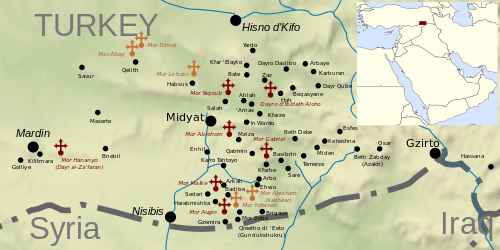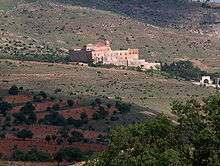Tur Abdin

Tur Abdin (Syriac: ܛܘܼܪ ܥܒ݂ܕܝܼܢ) is a hilly region situated in southeast Turkey, including the eastern half of the Mardin Province, and Şırnak Province west of the Tigris, on the border with Syria. The name 'Tur Abdin' is derived from Syriac, meaning "mountain of the servants (of God)". Tur Abdin is of great importance to Syriac Orthodox Christians, for whom the region used to be a monastic and cultural heartland.[1] The Syriac Orthodox community of Tur Abdin call themselves Suroye and Suryoye and traditionally speak a central Neo-Assyrian dialect called Turoyo.[2]
Geography
Settlements
The town of Midyat and the villages of Hah, Bequsyone, Dayro da-Slibo, Salah (with the old monastery of Mor Yaqub), Iwardo (with Mor Huschabo), Anhel, Kafro, Arkah (Harabale, with Dayro Mor Malke), Beth Sbirino, Miden (Middo), Kerburan, Binkelbe with Mor Samun Zayte and Beth Zabday (Azech) were all important Syriac Orthodox places among with countless other villages. Hah has the ancient `Idto d'Yoldath-Aloho, the Church of the Mother of God.
History

Antiquity
The Assyrian presence in Tur Abdin dates back to the 13th century BC; mentioned in the inscriptions of the Assyrian king Adad-nirari I, where Mount Izla was called the Kashiari mountain.[3] The area may be that of the ancient city and bishopric of Rhandus, which belonged to the late Roman province of Mesopotamia Secunda.
Modern
During World War I, 500,000 Syriac Christians were killed in the Ottoman Empire's Christian Genocide (called in Syriac Sayfo, simply 'the sword'). In the last few decades, caught between Turkish assimilation policies against Kurds, and Kurdish resistance, many Syriacs have fled the region or been killed. Today there are only 5,000, a quarter of the Christian population thirty years ago. Most have fled to Syria (where the city of Qamishli was built by them), Europe (particularly Sweden, Germany, the United Kingdom and the Netherlands), Australia and the United States. In the past few years, a few families have returned to Tur Abdin.
Recent conflicts
On 10 February 2006 and the following day, large demonstrations took place in the city of Midyat in Tur Abdin. Muslims angry about the Jyllands-Posten Muhammad cartoons gathered in Estel, the new part of the city, and started to march towards the old part of Midyat (6 kilometers away), where the Christians live. The mob was stopped by the police before reaching old Midyat.
In 2008 a series of legal challenges were made against the monastery of Mor Gabriel. Some local Kurdish villages sought to claim land on which the monastery had paid taxes since the 1930s as belonging to the villages, and made other accusations against the monastery. This led to considerable diplomatic and Human Rights action throughout Europe and within Turkey.[4]
Monasteries

The most important Syriac Orthodox centre in Tur Abdin is the monastery of Dayro d-Mor Hananyo, 6 km south east of Mardin, in the west of the region. Built from yellow rock, the monastery is affectionately known as Dayro d Kurkmo in Syriac, Dayr al-Zafaran in Arabic, or Deyrülzafarân in Turkish: the Safron Monastery. Founded in AD 493, the monastery was the residence of the Syriac Orthodox Patriarch from 1160 to 1932. Although the patriarch now lives in Damascus the monastery still contains the patriarchal throne and tombs of seven patriarchs and metropolitans. Today the monastery is led by a bishop and a monk and some lay assistants, and is a school for orphans. The bishop of Mor Hananyo is also the patriarchal vicar of Mardin. His goal is to rebuild the monastery and to preserve the history of the Syriac Orthodox church. The Dayro d-Mor Hananyo is part of the UNESCO world cultural heritage and was visited by numerous celebrities e.g. like Prince Charles.
In the centre of the Tur Abdin region, a few miles south of Midyat, is Dayro d-Mor Gabriel. Built in AD 397, Mor Gabriel monastery, is the oldest functioning Syriac Orthodox monastery on earth. It is the residence of the Metropolitan Bishop of Tur Abdin, seven nuns, four monks and a host of guests, assistants and students. The monastery is charged with keeping the flame of Syriac Orthodox faith alive in Tur Abdin, for which it is as much a fortress as a church.[5]
The Saffron and Mor Gabriel monasteries are the most important of the region, existing along with six or seven other active monasteries:
- The Mor Augin Monastery, located on the southern slope of Mt. Izla, has only been recently revived. It has a historical significance to the region. As evidence of that, a Syriac Orthodox Bishop in the Netherlands took the name Augin in respect for the founder of the monastery.
- The Mor Abroham Monastery is located less than a mile east of Midyat, and it is known for having a large amount of farmland, some of which they donated to house Syrian refugees. Directly adjacent to the omnastery lies the Turabdin Hotel and winery, which uses the monasteries vineyards to produce unique Syriac wines endemic to the region.
- The St. Meryemana (Mary) Monastery, located next to the village of Antili, functions as the religious center for the remaining Christians of the village, and has a school for Syriac children.
- The Mor Yakup (Jacob) Monastery is located next to the village of Baristepe, and, like the St Mary Monastery, functions as the religious center for the remaining Christians of the village.
- A second Mor Yakup Monastery is located in the village of Dibek (Syriac Badibe), having been rebuilt and occupied in 2013.[6]
- The Mor Malke Monastery is located on the northern slope of Mount Izla and is a few miles south of the village of Üçköy; it is connected by road to the village. Mor Malke is one of the newer monasteries of the region in terms of architecture, as it was rebuilt in the 30s. The monastery has a school, a church, and some farmlands.[7]
- One Monastery known as The Mor Aho Monastery was abandoned during the 1900s, but was later turned into a small walled village, when two dozen or so Syriac villagers built houses in the courtyard of the Monastery because its high walls allowed for better security and defense than what their nearby village provided. The Monastery has one Nun, but as it has no monks or consistent liturgy held in its church it is technically not a monastery.[8]
Notable people
- Ibrahim Baylan, Swedish minister, born in Tur Abdin
See also
| Wikimedia Commons has media related to Tur Abdin. |
References
- ↑ Aphram I. Barsoum; Ighnāṭyūs Afrām I (Patriarch of Antioch) (2008). The History of Tur Abdin. Gorgias Press. ISBN 978-1-59333-715-5.
- ↑ Wolfhart Heinrichs (1990). Studies in Neo-Aramaic. Scholars Press. pp. xi, 189. ISBN 978-1-55540-430-7.
- ↑ J. M. Munn-Rankin (1967). Assyrian Military Power. Cambridge University. p. 7.
- ↑ The Case of the St. Gabriel Syriac Monastery in Midyat, Turkey , 2010.
- ↑ http://www.academia.edu/1860499/Syriac_Monasticism_in_Tur_Abdin_A_Present-Day_Account. Missing or empty
|title=(help) - ↑ [kirchenleitung-unterwegs.ekvw.de/2014/04/30/ein-christliches-lebenszeichen-dorf-der-rueckkehrer/ kirchenleitung-unterwegs.ekvw.de/2014/04/30/ein-christliches-lebenszeichen-dorf-der-rueckkehrer/] Check
|url=value (help). Missing or empty|title=(help) - ↑ http://souf.nu/tur-abdin-resan-2014-dag-9-10. Missing or empty
|title=(help) - ↑ https://www.aina.org/ata/2013101916954.htm. Missing or empty
|title=(help)
External links
- The Diocese of Linz Eastern Christian Initiative and the Friends of Tur Abdin (German)
- Maps of Tur Abdin
- Webmagazine Shlama
- Margonitho - Syriac Orthodox Resources (see Churches & Monasteries, History and the Rev Stephen Griffith Reports from Tur Abdin)
Coordinates: 37°24′N 41°29′E / 37.400°N 41.483°E